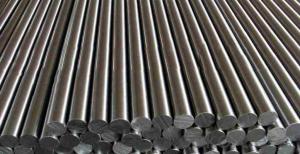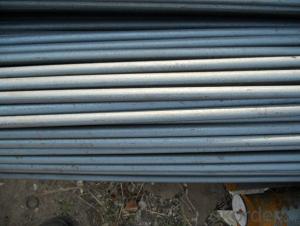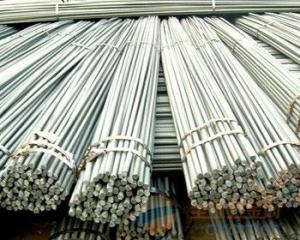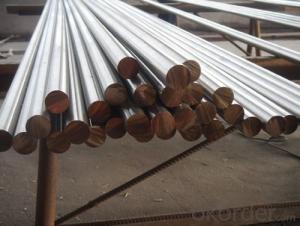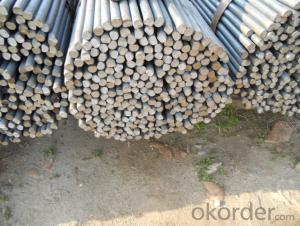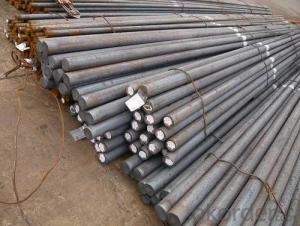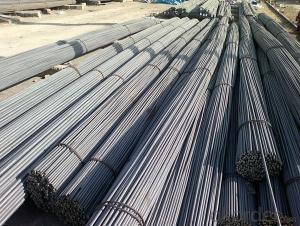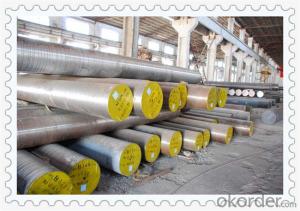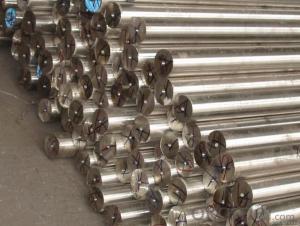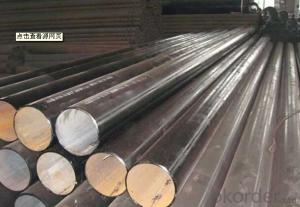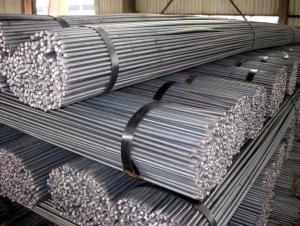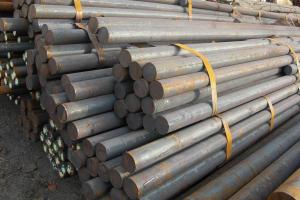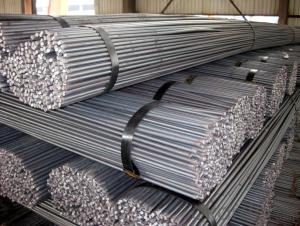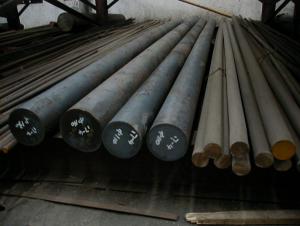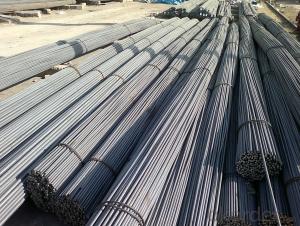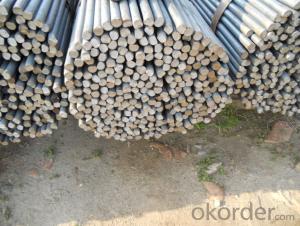Hot Rolled Steel Round Bars for Making Parts
- Loading Port:
- Tianjin
- Payment Terms:
- TT or LC
- Min Order Qty:
- 50 m.t.
- Supply Capability:
- 10000 m.t./month
OKorder Service Pledge
OKorder Financial Service
You Might Also Like
Product Description:
Hot Rolled Steel Round Bars for Making Parts is used for manufacturing ball, roller bearing steel and rings. Bearing in work is under great pressure and friction, so have high demands bearing steel and hardness and resistance, and high elastic limit.
Bearing steels are used for ball and roller bearing applications and are comprised of low carbon steels and high carbon through harden able steel.
For example, bearing ring, steel rolling mill, machinery, 100Cr6 bearing steel ball is widely used in high-speed and low-noise bearing, bicycle, motorcycle, automobile, bags electronically.
Product Applications:
Hot Rolled Steel Round Bars for Making Parts are ideal for structural applications and are widely used in the construction of buildings and bridges, and the manufacturing, petrochemical, and transportation industries.
1. Steel round bar products is used in construction and a large number of architectural and engineering structures. And it can be used in production of handrail, windows, machinery, telecom and curtain wall.
2. It can be used in the fields like metal mines, cement plants, water coal slurry, power stations and chemical industry.
3. Besides, we can supply some especial material steel round bar that can be used for main shaft of steamer, hummer shank, with big section and supper force.
4. Recommended watchcase factory, screw factory and other cold stamping products industry use.
Product Advantages:
OKorder's Hot Rolled Steel Round Bars for Making Parts are durable, strong, and resist corrosion.
1. The steel in which the main interstitial alloying constituent is carbon in the range of 0.12–2.0%.
2. As the carbon percentage content rises, steel has the ability to become harder and stronger through heat treating; however it becomes less ductile.
3. Regardless of the heat treatment, higher carbon content reduces weld ability. In carbon steels, the higher carbon content lowers the melting point.
4. Quality should be in conformity with the specification of the manufacturer. Quantity and packing conditions should be in conformity with the term in the contract.
Main Product Features:
· Premium quality
· Prompt delivery & seaworthy packing (30 days after receiving deposit)
· Corrosion resistance
· Can be recycled and reused
· Mill test certification
· Professional Service
· Competitive pricing
Specifications of Hot Rolled Steel Round Bars for Making Parts
1. Grade: Q235, A36, SS400, S235JR
2. Feature: Unbreakable, grinding resistant and high impact value
3. Diameter: 8mm-150mm
4. Performance: Mainly for civil construction
5. Characteristics: Even hardness, no deformation, no breaking, no mal-roundness
6. Technique: Hot rolled
7. Mass: Mass (kg/m) = Diameter (mm) × Diameter (mm) × 0.00617
Packaging & Delivery of Mild Hot Rolled Steel Round Bars for Bults and Nults
Packaging Detail: All goods are packed in bundle with steel strips and shipped by break bulk vessel or container (depend on target market and different ports)
Delivery Detail: 45 days
Trade terms: FOB, CFR, CIF
MOQ: 25 tons per specification; we can negotiate the quantity if the specification is normal or we have stock of one specification.
Weight: The price invoicing on theoretical weight basis or actual weight basis depends on customer’s request.
Shipment: The shipment of bulk break or container is depends on customer’s request and the situation of the port of destination.
Documents given: Full set of original clean on board bill of lading; Original signed commercial invoice; Original packing list; Policy of insurance; Certificate of origin and what the target market needs.
Production Flow of Hot Rolled Steel Round Bars for Making Parts
Material prepare (billet) — heat up — rough rolling — precision rolling — cooling — packing — storage and transportation
FAQ:
Q1: The products are invoicing on theoritical weight or on actual weight?
A1: We can do it in both manners, according to the customers' request.
Q2: What is the normal tolerance of Hot Rolled Steel Round Bars for Making Parts?
A2: Normally 3%-5%, but we can also produce the goods according to the customers' requests.
Q3: How soon can we receive the product after purchase?
A3: Within three days of placing an order, we will begin production. The specific shipping date is dependent upon international and government factors, but is typically 7 to 10 workdays.
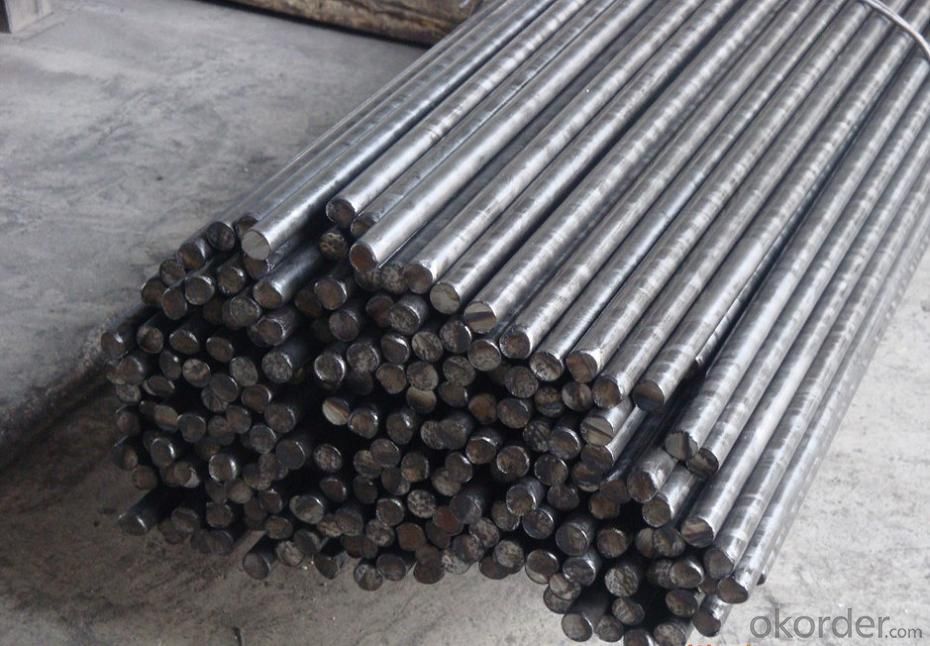
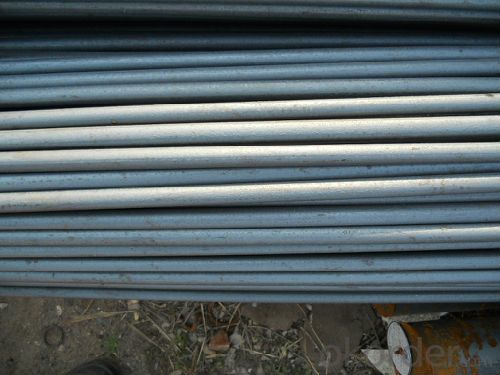
- Q: How do steel round bars perform under vibration or resonance?
- Steel round bars generally perform well under vibration or resonance due to their high strength and stiffness. The inherent properties of steel, such as its high modulus of elasticity and low damping characteristics, make it an ideal material for applications that involve vibration or resonance. When subjected to vibration or resonance, steel round bars tend to exhibit minimal deformation or deflection. This is because steel has a high natural frequency, which allows it to resist the excitation caused by external forces or vibrations. The high stiffness of steel also helps in maintaining its shape and integrity under these conditions. Furthermore, steel round bars have good fatigue resistance, which means they can withstand repeated loading and unloading cycles without significant degradation in performance. This is especially important in applications where the material is subjected to cyclic loading or vibrations over an extended period. However, it is worth noting that the performance of steel round bars under vibration or resonance can be influenced by factors such as the design of the structure, the applied loads, and the frequency and amplitude of the vibrations. In some cases, additional measures, such as damping materials or isolation systems, may need to be implemented to mitigate the effects of vibration or resonance on steel round bars. Overall, steel round bars are known for their excellent performance under vibration or resonance, making them a popular choice in various industries, including construction, automotive, and aerospace. Their high strength, stiffness, and fatigue resistance make them reliable and durable materials for applications that involve dynamic loads or vibrations.
- Q: What are the different types of steel round bar alloys used in the automotive industry?
- Different types of steel round bar alloys are utilized in the automotive industry for their distinct properties and applications. 1. Carbon Steel: Carbon steel round bars are extensively employed due to their favorable attributes of strength and toughness. They find use in various automotive components like axles, crankshafts, and gears. 2. Alloy Steel: Alloy steel round bars comprise additional alloying elements such as chromium, nickel, or molybdenum. These alloys enhance the mechanical properties of the steel, rendering it stronger and more durable. Automotive applications like suspension components, drive shafts, and steering components commonly employ alloy steel round bars. 3. Stainless Steel: Automotive applications that demand durability in harsh environments benefit from the highly corrosion-resistant nature of stainless steel round bars. Exhaust systems, fuel tanks, and body parts are frequently made using stainless steel. 4. Tool Steel: Tool steel round bars exhibit high hardness, wear resistance, and toughness. They are predominantly used in the production of automotive tools and dies, like punches, dies, and cutting tools. 5. Bearing Steel: Bearing steel round bars are specifically designed to offer excellent wear resistance and high load-carrying capacity in automotive bearings. These bars possess a high level of hardness and undergo heat treatment to ensure optimal performance. 6. Spring Steel: Automotive suspension systems and other applications that necessitate exceptional elasticity and fatigue resistance utilize spring steel round bars. These bars are capable of enduring repeated stress while maintaining their shape, making them ideal for automotive springs and stabilizer bars. It is crucial to consider the desired properties, performance requirements, and cost considerations of each automotive component when selecting a specific steel alloy.
- Q: What are the different types of steel round bar coatings used in the oil and gas industry?
- Various coatings are commonly utilized in the oil and gas industry to enhance the durability and corrosion resistance of steel round bars. These coatings are essential for protecting the steel from the harsh conditions faced in oil and gas production, transportation, and refining processes. 1. Galvanized Coating: To enhance corrosion resistance, a layer of zinc is applied to the steel round bar through galvanization. This coating effectively safeguards the steel against moisture, chemicals, and exposure to the elements. Galvanized coatings find extensive usage in pipelines, offshore platforms, and storage tanks within the oil and gas industry. 2. Fusion Bonded Epoxy (FBE) Coating: FBE coating involves applying a thermosetting epoxy powder coating to the steel round bar using electrostatic spray. The coating is then fused with heat to form a robust, long-lasting, and corrosion-resistant layer. FBE coatings are widely employed in pipelines, valves, and fittings, providing excellent protection against corrosion, abrasion, and chemicals. 3. Polyethylene (PE) Coating: The application of a polyethylene layer to the steel round bar through extrusion or wrapping methods is known as PE coating. This coating is commonly utilized in oil and gas industry pipelines due to its exceptional resistance to corrosion, chemicals, and impact. Additionally, PE coatings are renowned for their flexibility, enabling the coated bars to withstand ground movement and temperature fluctuations. 4. Polypropylene (PP) Coating: Similar to PE coating, PP coating employs polypropylene instead. PP coatings offer comparable benefits to PE coatings, including corrosion resistance, chemical resistance, and flexibility. They are frequently employed in pipelines within the oil and gas industry, particularly in areas with higher temperatures or where chemical resistance is crucial. 5. Zinc-Nickel Coating: Zinc-nickel coatings involve electroplating a layer of zinc-nickel alloy onto the steel round bar. This coating provides outstanding corrosion protection, even in demanding environments such as offshore installations or high-salinity areas. Zinc-nickel coatings excel in both corrosion and abrasion resistance, making them highly suitable for diverse oil and gas applications. Overall, the utilization of these various steel round bar coatings plays a vital role in preserving the integrity and longevity of equipment and infrastructure in the oil and gas industry. They ensure that the steel bars can endure the challenging conditions encountered during exploration, production, and transportation, thereby reducing maintenance requirements and enhancing safety and reliability.
- Q: What are the advantages of using tool steel round bars?
- There are several advantages to using tool steel round bars. Firstly, tool steel round bars offer exceptional hardness and wear resistance. This makes them ideal for applications where the material needs to withstand high levels of stress, such as in the manufacturing of cutting tools, dies, and molds. The hardness of tool steel also allows for precise machining, resulting in accurate and intricate shapes. Secondly, tool steel round bars have excellent toughness and impact resistance. This means that they can withstand heavy-duty applications without breaking or cracking. This makes them suitable for use in demanding industries such as aerospace, automotive, and construction. Furthermore, tool steel round bars are known for their high temperature resistance. They can maintain their hardness and strength even under extreme heat conditions. This feature is particularly advantageous in applications where the material is exposed to high temperatures, such as in forging or heat treating operations. Another advantage of using tool steel round bars is their dimensional stability. They have a low coefficient of thermal expansion, meaning they do not undergo significant dimensional changes when exposed to temperature variations. This makes them highly reliable and predictable in various operating conditions. Moreover, tool steel round bars can be easily machined and heat treated to achieve specific properties. This versatility allows manufacturers to tailor the material to their specific needs, enhancing the overall performance of the end product. Lastly, tool steel round bars are readily available and cost-effective. They are widely produced and stocked by suppliers, making them easily accessible for various applications. Additionally, their long lifespan and resistance to wear and tear contribute to their cost-effectiveness. In conclusion, the advantages of using tool steel round bars include exceptional hardness, toughness, high temperature resistance, dimensional stability, versatility, availability, and cost-effectiveness. These properties make them a preferred choice in industries where durability, precision, and reliability are crucial.
- Q: What are the common sizes and dimensions of steel round bars?
- Common sizes and dimensions of steel round bars vary depending on the application and industry. However, some commonly available sizes range from 1/4 inch to 24 inches in diameter, with lengths typically ranging from 10 to 20 feet. Additionally, standard dimensions for steel round bars often follow ASTM (American Society for Testing and Materials) specifications.
- Q: How are steel round bars used in the manufacturing of machinery and equipment?
- Due to their inherent strength, durability, and versatility, steel round bars find extensive use in the production of machinery and equipment. These bars, typically made from carbon steel or alloy steel, are available in various diameters and lengths. One of the common applications of steel round bars is in fabricating shafts and axles, which are crucial for transmitting rotational motion and torque in machinery. These bars offer the necessary strength and stiffness to withstand the forces and stresses experienced during operation. They are often machined precisely and subsequently heat-treated to enhance their mechanical properties, such as hardness and toughness. Another significant use of steel round bars is in the manufacture of gears and sprockets. These components are essential for transmitting power and motion between different machine parts. Steel round bars are machined to form teeth or cogs that interlock, ensuring smooth and efficient operation. The high strength and wear resistance of steel enable gears and sprockets to endure heavy loads and repetitive motion without distorting or failing. Steel round bars also find application in manufacturing various machine components like bearings, couplings, and fasteners. Bearings, for example, depend on the strength and hardness of steel to support rotating or sliding shafts while minimizing friction and wear. Couplings, on the other hand, utilize steel round bars to connect different machine parts, efficiently transmitting power and motion. Steel round bars also serve as fasteners, providing a secure and dependable connection between different machine elements. Furthermore, steel round bars are frequently used in constructing machine frames and structures. Their high strength-to-weight ratio makes them ideal for providing structural support and stability. By utilizing steel round bars, manufacturers can create robust and reliable machinery and equipment capable of withstanding heavy loads, vibrations, and other challenging operating conditions. In conclusion, steel round bars play a vital role in the manufacturing of machinery and equipment. Their exceptional strength, durability, and versatility make them a favored choice for a wide range of applications. Whether it is for shafts, gears, bearings, or machine frames, steel round bars provide the necessary mechanical properties to ensure the reliable and efficient operation of machinery and equipment.
- Q: Can steel round bars be used for making fuel system components?
- No, steel round bars are not suitable for making fuel system components as they lack the necessary corrosion resistance and compatibility with fuels.
- Q: What is the difference between carbon steel and stainless steel round bars?
- Carbon steel and stainless steel round bars differ primarily in their composition and properties. Carbon steel is primarily made up of iron and carbon, with trace amounts of other elements. It is known for its strength and durability, making it ideal for various applications in industries such as construction and automotive. Carbon steel round bars are generally more affordable than stainless steel round bars. Stainless steel, on the other hand, is a steel alloy that contains at least 10.5% chromium. This addition of chromium gives stainless steel its unique properties, including corrosion resistance. Stainless steel round bars are highly resistant to rust and staining, making them suitable for applications in environments exposed to moisture and chemicals. They are commonly used in industries such as food processing, medical equipment, and marine applications. Due to the chromium content, stainless steel round bars are generally more expensive than carbon steel round bars. However, the added cost is justified by their superior corrosion resistance and aesthetic appeal. Stainless steel also offers different grades and finishes, allowing for customization based on specific requirements. In summary, the main difference between carbon steel and stainless steel round bars lies in their composition and properties. Carbon steel is strong and affordable, while stainless steel offers corrosion resistance and comes in various grades and finishes. The choice between the two depends on the specific application and the desired properties required for the project.
- Q: Are steel round bars suitable for use in the mining industry?
- The mining industry finds steel round bars to be suitable for use. These bars are renowned for their strength and durability, making them an ideal choice for heavy-duty equipment and machinery in mining. They can be utilized in various ways, such as shafts, support beams, and structural components in underground mines, open-pit mines, and processing plants. The steel round bars have the capability to withstand high loads and pressures, enabling them to thrive in harsh mining environments. They possess excellent tensile strength and can endure extreme temperatures, resulting in resistance to wear, abrasion, and impact. This is especially valuable in mining operations where equipment is subjected to heavy loads, vibrations, and constant movement. Furthermore, the steel round bars are easily weldable, fabricated, and machined to meet specific requirements, making them versatile and adaptable for a wide range of mining applications. They can be customized in terms of size, length, and shape, ensuring a perfect fit for various mining equipment and structures. Beyond their strength and versatility, steel round bars also offer cost-effectiveness and long-term value. They have a long lifespan, require minimal maintenance, and can withstand the harsh conditions typically encountered in mining operations, reducing the need for frequent replacements or repairs. Overall, steel round bars are a reliable and suitable choice for the mining industry due to their strength, durability, versatility, and cost-effectiveness. They provide the necessary support and structural integrity required for mining operations, ensuring the safety and efficiency of the industry.
- Q: What are the different types of steel round bar alloys for improved strength?
- There are several different types of steel round bar alloys that are known for their improved strength. These alloys are developed through the addition of various elements to the steel composition, resulting in different properties and strengths. One commonly used alloy for improved strength is carbon steel. This alloy contains a higher carbon content, which enhances its strength and hardness. Carbon steel round bars are widely used in applications that require high strength, such as construction, automotive, and machinery. Another type of alloy is stainless steel, which is known for its corrosion resistance and high strength. Stainless steel round bars are often used in environments where corrosion is a concern, such as marine applications, food processing, and chemical plants. Alloy steel is another category that offers improved strength. This type of steel is created by adding elements such as chromium, molybdenum, and nickel to the composition. Alloy steel round bars are commonly used in industries that require high strength and durability, such as aerospace, oil and gas, and power generation. Tool steel is yet another alloy that provides enhanced strength and toughness. Tool steel round bars are specifically designed for machining and cutting applications, where high wear resistance and hardness are crucial. Lastly, there are specialty alloys such as nickel alloy and titanium alloy round bars, which offer exceptional strength and unique properties for specific applications. Nickel alloy round bars are often used in industries such as aerospace, chemical, and nuclear, while titanium alloy round bars are commonly found in aerospace, medical, and automotive industries. In conclusion, the different types of steel round bar alloys for improved strength include carbon steel, stainless steel, alloy steel, tool steel, and specialty alloys. Each of these alloys has its own unique properties and applications, providing a wide range of options for industries that require high strength materials.
Send your message to us
Hot Rolled Steel Round Bars for Making Parts
- Loading Port:
- Tianjin
- Payment Terms:
- TT or LC
- Min Order Qty:
- 50 m.t.
- Supply Capability:
- 10000 m.t./month
OKorder Service Pledge
OKorder Financial Service
Similar products
Hot products
Hot Searches
Related keywords
